Submitted:
22 August 2024
Posted:
23 August 2024
You are already at the latest version
Abstract
Keywords:
1. Introduction
2. Materials and Methods
2.1. Description of the Study Protected Areas
2.2. Satellite Image Collection and Processing
2.2.1. Base Map Collection
2.2.2. Acquisition of Long-Term Satellite Image
2.2.3. Scan Line Error (SLC) Correction
2.2.4. Filtering the Bad-Quality Pixels
2.3. Calculation of Spectral Vegetation Indices
2.4. Land Cover Classification
2.5. Statistical Analysis
3. Results
3.1. Overall Trend of Land Cover Change in the Six Study Areas over the co-Management Period
3.2. Protected Area-Specific Trends in Land Cover Change during the Co-Management Period
3.3. Pixel-to-Pixel Changes of Vegetation Indices Over Time
3.4. Forest Cover Change from Global Forest Watch Data
4. Discussion
4.1. Co-Management Approach Reduces Forest Cover in Major Protected Areas
4.2. Co-Management Approach Increases Forest Cover in LNP
4.3. Co-management Approach Affects Total Vegetation Cover in Pilot Protected Areas for Co-management
4.4. Forest and Total Vegetation Cover in Forests without Co-management Practices
5. Conclusions
Supplementary Materials
Author Contributions
Funding
Data Availability Statement
Acknowledgments
Conflicts of Interest
References
- Krsnik, G.; Reynolds, K.M.; Murphy, P.; Paplanus, S.; Garcia-Gonzalo, J.; González Olabarria, J.R. Forest Use Suitability: Towards Decision-Making-Oriented Sustainable Management of Forest Ecosystem Services. Geogr. Sustain. 2023, 4, 414–427. [Google Scholar] [CrossRef]
- Poudyal, B.H.; Maraseni, T.; Cockfield, G. Scientific Forest Management Practice in Nepal: Critical Reflections from Stakeholders’ Perspectives. Forests 2020, 11. [Google Scholar] [CrossRef]
- Charmakar, S.; Kimengsi, J.N.; Giessen, L. Power in Forest Management Institutions: A Systematic Review. Trees For. People 2024, 15, 100465. [Google Scholar] [CrossRef]
- De Pourcq, K.; Thomas, E.; Arts, B.; Vranckx, A.; Léon-Sicard, T.; Van Damme, P. Conflict in Protected Areas: Who Says Co-Management Does Not Work? PLOS ONE 2016, 10, e0144943. [Google Scholar] [CrossRef]
- Ghorbani, M.; Azadi, H. A Social-Relational Approach for Analyzing Trust and Collaboration Networks as Preconditions for Rangeland Comanagement. Rangel. Ecol. Manag. 2021, 75, 170–184. [Google Scholar] [CrossRef]
- Islam, K.N.; Rahman, M.M.; Jashimuddin, M.; Hossain, M.M.; Islam, K.; Faroque, M.A. Analyzing Multi-Temporal Satellite Imagery and Stakeholders’ Perceptions to Have an Insight into How Forest Co-Management Is Changing the Protected Area Landscapes in Bangladesh. For. Policy Econ. 2019, 101, 70–80. [Google Scholar] [CrossRef]
- Quimby, B.; Levine, A. Participation, Power, and Equity: Examining Three Key Social Dimensions of Fisheries Comanagement. Sustainability 2018, 10. [Google Scholar] [CrossRef]
- Bardsley, D.K.; Bardsley, A.M.; Moskwa, E.; Weber, D.; Robinson, G.M. Challenges to the Co-Management of Biodiversity in a Reflexive Modernity. Geogr. Res. 2021, 59, 362–377. [Google Scholar] [CrossRef]
- Plummer, R.; Armitage, D.R.; de Loë, R.C. Adaptive Comanagement and Its Relationship to Environmental Governance. Ecol. Soc. 2013, 18. [Google Scholar] [CrossRef]
- Takahashi, K.; Kosugi, Y.; Kanazawa, A.; Sakabe, A. Automated Closed-Chamber Measurements of Methane Fluxes from Intact Leaves and Trunk of Japanese Cypress. Atmos. Environ. 2012, 51, 329–332. [Google Scholar] [CrossRef]
- Chinangwa, L.L.; Pullin, A.S.; Hockley, N. Impact of Forest Co-Management Programs on Forest Conditions in Malawi. J. Sustain. For. 2017, 36, 338–357. [Google Scholar] [CrossRef]
- Nagendra, H.; Tucker, C.; Carlson, L.; Southworth, J.; Karmacharya, M.; Karna, B. Monitoring Parks through Remote Sensing: Studies in Nepal and Honduras. Environ. Manage. 2004, 34, 748–760. [Google Scholar] [CrossRef] [PubMed]
- Niraula, R.R.; Gilani, H.; Pokharel, B.K.; Qamer, F.M. Measuring Impacts of Community Forestry Program through Repeat Photography and Satellite Remote Sensing in the Dolakha District of Nepal. J. Environ. Manage. 2013, 126, 20–29. [Google Scholar] [CrossRef]
- Gondwe, M.F.; Cho, M.A.; Chirwa, P.W.; Geldenhuys, C.J. Land Use Land Cover Change and the Comparative Impact of Co-Management and Government-Management on the Forest Cover in Malawi (1999-2018). J. Land Use Sci. 2019, 14, 281–305. [Google Scholar] [CrossRef]
- Kaiser, E.T.; Roberts, K.; Pawkham, J.; Thongdi, B.; Morikawa, R.; Satre, D. Healthy Forest, Healthy People: Remote Sensing and Monitoring Support Implementation of Community Forestry in Thailand. In Proceedings of the 2012 IEEE Global Humanitarian Technology Conference, Seattle, WA, USA, October 21 2012; pp. 111–116. [Google Scholar]
- Kimengsi, J.N.; Bhusal, P.; Aryal, A.; Fernandez, M.V.; Owusu, R.; Chaudhary, A.; Nielsen, W. What (De)Motivates Forest Users’ Participation in Co-Management? Evidence from Nepal. Forests 2019, 10. [Google Scholar] [CrossRef]
- Rasheed, S.K.B. Participatory Forestry as a Strategy for Reforestation in Bangladesh. GeoJournal 1995, 37, 39–44. [Google Scholar] [CrossRef]
- Sarker, S.K.; Deb, J.C.; Halim, M.A. A Diagnosis of Existing Logging Bans in Bangladesh. Int. For. Rev. 2011, 13, 461–475. [Google Scholar] [CrossRef]
- Chowdhury, M.S.H.; Koike, M. An Overview on the Protected Area System for Forest Conservation in Bangladesh. J. For. Res. 2010, 21, 111–118. [Google Scholar] [CrossRef]
- Chowdhury, M.S.H.; Gudmundsson, C.; Izumiyama, S.; Koike, M.; Nazia, N.; Rana, M.P.; Mukul, S.A.; Muhammed, N.; Redowan, M. Community Attitudes toward Forest Conservation Programs through Collaborative Protected Area Management in Bangladesh. Environ. Dev. Sustain. 2014, 16, 1235–1252. [Google Scholar] [CrossRef]
- Rahman, M.M.; Mahmud, M.A.A.; Ahmed, F.U. Restoration of Degraded Forest Ecosystem through Non-Forestry Livelihood Supports: Experience from the Chunati Wildlife Sanctuary in Bangladesh. For. Sci. Technol. 2017, 13, 109–115. [Google Scholar] [CrossRef]
- Rashid, A.Z.M.M.; Craig, D.; Mukul, S.A.; Khan, N.A. A Journey towards Shared Governance: Status and Prospects for Collaborative Management in the Protected Areas of Bangladesh. J. For. Res. 2013, 24, 599–605. [Google Scholar] [CrossRef]
- Rahman, M.S.; Miah, S.; Giessen, L. A New Model of Development Coalition Building: USAID Achieving Legitimate Access and Dominant Information in Bangladesh’s Forest Policy. World Dev. 2018, 105, 248–261. [Google Scholar] [CrossRef]
- Islam, M.W.; Ahmed, S.; Mahin, R.T. Motivation in Community-Based Tourism: Linking Locals to Internationals in Promoting Community Development and Conservation of Natural Resources. In Strategic Tourism Planning for Communities; Sharma, A., Arora, S., Eds.; Building the Future of Tourism; Emerald Publishing Limited: Leeds, 2024; pp. 221–245. ISBN 978-1-83549-016-7. [Google Scholar]
- Mukul, S.A.; Rashid, A.Z.M.M.; Quazi, S.A.; Uddin, M.B.; Fox, J. Local Peoples’ Responses to Co-Management Regime in Protected Areas: A Case Study from Satchari National Park, Bangladesh. For. Trees Livelihoods 2012, 21, 16–29. [Google Scholar] [CrossRef]
- Oldekop, J.A.; Holmes, G.; Harris, W.E.; Evans, K.L. A Global Assessment of the Social and Conservation Outcomes of Protected Areas. Conserv. Biol. 2016, 30, 133–141. [Google Scholar] [CrossRef] [PubMed]
- Bilyaminu, H.; Radhakrishnan, P.; Vidyasagaran, K.; Srinivasan, K. Monitoring Land Use and Land Cover Change of Forest Ecosystems of Shendurney Wildlife Sanctuary, Western Ghats, India. Asian J. Environ. Ecol. 2021, 15, 20–27. [Google Scholar] [CrossRef]
- Meli Fokeng, R.; Gadinga Forje, W.; Meli Meli, V.; Nyuyki Bodzemo, B. Multi-Temporal Forest Cover Change Detection in the Metchie-Ngoum Protection Forest Reserve, West Region of Cameroon. Egypt. J. Remote Sens. Space Sci. 2020, 23, 113–124. [Google Scholar] [CrossRef]
- Negassa, M.D.; Mallie, D.T.; Gemeda, D.O. Forest Cover Change Detection Using Geographic Information Systems and Remote Sensing Techniques: A Spatio-Temporal Study on Komto Protected Forest Priority Area, East Wollega Zone, Ethiopia. Environ. Syst. Res. 2020, 9, 1. [Google Scholar] [CrossRef]
- Vogelmann, J.E.; DeFelice, T.P. Characterization of Intra-Annual Reflectance Properties of Land Cover Classes in Southeastern South Dakota Using Landsat TM and ETM+ Data. Can. J. Remote Sens. 2003, 29, 219–229. [Google Scholar] [CrossRef]
- Xue, J.; Su, B. Significant Remote Sensing Vegetation Indices: A Review of Developments and Applications. J. Sens. 2017, 2017, 1353691. [Google Scholar] [CrossRef]
- da Silva, V.S.; Salami, G.; da Silva, M.I.O.; Silva, E.A.; Monteiro Junior, J.J.; Alba, E. Methodological Evaluation of Vegetation Indexes in Land Use and Land Cover (LULC) Classification. Geol. Ecol. Landsc. 2020, 4, 159–169. [Google Scholar] [CrossRef]
- Zafar, T.B.; Ding, W.; Din, S.U.; Khan, G.M.; Hao, C.; He, L. Forest Cover and Land Use Map of the Chunati Wildlife Sanctuary Based on Participatory Mapping and Satellite Images: Insight into Chunati Beat. Land Use Policy 2021, 103, 105193. [Google Scholar] [CrossRef]
- Islam, K.; Jashimuddin, M.; Nath, B.; Nath, T.K. Quantitative Assessment of Land Cover Change Using Landsat Time Series Data: Case of Chunati Wildlife Sanctuary (CWS), Bangladesh. Int. J. Environ. Geoinformatics 2016, 3, 45–55. [Google Scholar] [CrossRef]
- Ahmed, N.; Mahbub, R.B.; Hossain, M.M.; Sujauddin, M. Modelling Spatio-Temporal Changes of Tropical Forest Cover in the North-Eastern Region of Bangladesh. J. Trop. For. Sci. 2020, 32, 42–51. [Google Scholar]
- Ullah, S.M.A.; Tani, M.; Tsuchiya, J.; Rahman, M.A.; Moriyama, M. Impact of Protected Areas and Co-Management on Forest Cover: A Case Study from Teknaf Wildlife Sanctuary, Bangladesh. Land Use Policy 2022, 113, 105932. [Google Scholar] [CrossRef]
- Hossen, A.; Røskaft, E. A Case Study on Conflict Intensity between Humans and Elephants at Teknaf Wildlife Sanctuary, Cox’s Bazar, Bangladesh. Front. Conserv. Sci. 2023, 4, 1067045. [Google Scholar] [CrossRef]
- Chowdhury, M.S.H.; Koike, M.; Rana, P.; Muhammed, N. Community Development through Collaborative Management of Protected Areas: Evidence from Bangladesh with a Case of Rema-Kalenga Wildlife Sanctuary. Int. J. Sustain. Dev. World Ecol. 2013, 20, 63–74. [Google Scholar] [CrossRef]
- Chowdhury, M.S.H.; Koike, M. Therapeutic Use of Plants by Local Communities in and around Rema-Kalenga Wildlife Sanctuary: Implications for Protected Area Management in Bangladesh. Agrofor. Syst. 2010, 80, 241–257. [Google Scholar] [CrossRef]
- Karim, M.R.; Halim, M.A.; Gale, N.V.; Thomas, S.C. Biochar Effects on Soil Physiochemical Properties in Degraded Managed Ecosystems in Northeastern Bangladesh. Soil Syst. 2020, 4. [Google Scholar] [CrossRef]
- Mukul, S.A. Biodiversity Conservation and Ecosystem Functions of Traditional Agroforestry Systems: Case Study from Three Tribal Communities in and Around Lawachara National Park. In Forest conservation in protected areas of Bangladesh: Policy and community development perspectives; Chowdhury, M.S.H., Ed.; Springer International Publishing: Cham, 2014; pp. 171–179. ISBN 978-3-319-08147-2. [Google Scholar]
- Sohel, M.S.I.; Mukul, S.A.; Burkhard, B. Landscape׳s Capacities to Supply Ecosystem Services in Bangladesh: A Mapping Assessment for Lawachara National Park. Ecosyst. Serv. 2015, 12, 128–135. [Google Scholar] [CrossRef]
- Halim, M.A.; Shahid, A.; Chowdhury, M.S.H.; Nahar, M.N.; Sohel, M.S.I.; Nuruddin, M.J.; Koike, M. Evaluation of Land-Use Pattern Change in West Bhanugach Reserved Forest, Bangladesh, Using Remote Sensing and GIS Techniques. J. For. Res. 2008, 19, 193–198. [Google Scholar] [CrossRef]
- Islam, K.; Rahman, Md.F.; Jashimuddin, M. Modeling Land Use Change Using Cellular Automata and Artificial Neural Network: The Case of Chunati Wildlife Sanctuary, Bangladesh. Ecol. Indic. 2018, 88, 439–453. [Google Scholar] [CrossRef]
- Islam, K.N.; Rahman, M.M.; Jashimuddin, M.; Hossain, M.M.; Islam, K.; Faroque, M.A. Analyzing Multi-Temporal Satellite Imagery and Stakeholders’ Perceptions to Have an Insight into How Forest Co-Management Is Changing the Protected Area Landscapes in Bangladesh. For. Policy Econ. 2019, 101, 70–80. [Google Scholar] [CrossRef]
- Haque, A.K.M.K.; Khan, S.A.; Uddin, S.N.; Shetu, S.S. An Annotated Checklist of the Angiospermic Flora of Rajkandi Reserve Forest of Moulvibazar, Bangladesh. Bangladesh J. Plant Taxon. 2018, 25, 187. [Google Scholar] [CrossRef]
- NSP Base Maps, NSP (2003-2008); USAID: Dhaka, Bangladesh, 2017.
- UNEP-WCMC Protected Area Profile for Bangladesh from the World Database on Protected Areas Available online:. Available online: https://www.protectedplanet.net/country/BGD (accessed on 12 August 2024).
- Peng, D.; Zhang, B.; Liu, L.; Fang, H.; Chen, D.; Hu, Y.; Liu, L. Characteristics and Drivers of Global NDVI-Based FPAR from 1982 to 2006. Glob. Biogeochem. Cycles 2012, 26. [Google Scholar] [CrossRef]
- Claverie, M.; Vermote, E.F.; Franch, B.; Masek, J.G. Evaluation of the Landsat-5 TM and Landsat-7 ETM+ Surface Reflectance Products. Remote Sens. Environ. 2015, 169, 390–403. [Google Scholar] [CrossRef]
- Julia A., B.; Brian L., M.; Jeffrey S. C., M.; Dennis L., H.; Simon J., H.; John R., S.; Haque, M.O. andsat-7 ETM+ Radiometric Calibration Status.; San Diego, California, September 19 2016; Vol. 9972, p. 99720C.
- Masek, J.G.; Vermote, E.F.; Saleous, N.E.; Wolfe, R.; Hall, F.G.; Huemmrich, K.F.; Gao, F.; Kutler, J.; Lim, T.K. A Landsat Surface Reflectance Dataset for North America, 1990-2000. IEEE Geosci. Remote Sens. Lett. 2006, 3, 68–72. [Google Scholar] [CrossRef]
- Scaramuzza, P.; Micijevic, E.; Chander, G. SLC Gap-Filled Products Phase One Methodology, Landsat Technical Notes 2004.
- Zeng, C.; Shen, H.; Zhang, L. Recovering Missing Pixels for Landsat ETM+ SLC-off Imagery Using Multi-Temporal Regression Analysis and a Regularization Method. Remote Sens. Environ. 2013, 131, 182–194. [Google Scholar] [CrossRef]
- Ling, X.; Cao, R. A New Spatiotemporal Data Fusion Method to Reconstruct High-Quality Landsat Ndvi Time-Series Data. In Proceedings of the 2021 IEEE International Geoscience and Remote Sensing Symposium IGARSS, July 11 2021; pp. 2564–2567. [Google Scholar]
- Tahsin, S.; Medeiros, S.C.; Hooshyar, M.; Singh, A. Optical Cloud Pixel Recovery via Machine Learning. Remote Sens. 2017, 9. [Google Scholar] [CrossRef]
- Rokni, K.; Musa, T.A. Normalized Difference Vegetation Change Index: A Technique for Detecting Vegetation Changes Using Landsat Imagery. CATENA 2019, 178, 59–63. [Google Scholar] [CrossRef]
- Jiang, Z.; Huete, A.R.; Didan, K.; Miura, T. Development of a Two-Band Enhanced Vegetation Index without a Blue Band. Remote Sens. Environ. 2008, 112, 3833–3845. [Google Scholar] [CrossRef]
- Huete, A.R. A Soil-Adjusted Vegetation Index (SAVI). Remote Sens. Environ. 1988, 25, 295–309. [Google Scholar] [CrossRef]
- Qi, J.; Chehbouni, A.; Huete, A.R.; Kerr, Y.H.; Sorooshian, S. A Modified Soil Adjusted Vegetation Index. Remote Sens. Environ. 1994, 48, 119–126. [Google Scholar] [CrossRef]
- R Core Team R: A Language and Environment for Statistical Computing 2024.
- Helsel, D.R.; Frans, L.M. Regional Kendall Test for Trend. Environ. Sci. Technol. 2006, 40, 4066–4073. [Google Scholar] [CrossRef]
- Dillencourt, M.B.; Mount, D.M.; Netanyahu, N.S. A Randomized Algorithm for Slope Selection. Int. J. Comput. Geom. Appl. 1992, 02, 1–27. [Google Scholar] [CrossRef]
- Ullah, S.M.A.; Tani, M.; Tsuchiya, J.; Rahman, M.A.; Moriyama, M. Impact of Protected Areas and Co-Management on Forest Cover: A Case Study from Teknaf Wildlife Sanctuary, Bangladesh. Land Use Policy 2022, 113, 105932. [Google Scholar] [CrossRef]
- Rahman, Md.H.; Miah, Md.D. Are Protected Forests of Bangladesh Prepared for the Implementation of REDD+? A Forest Governance Analysis from Rema-Kalenga Wildlife Sanctuary. Environments 2017, 4, 43. [Google Scholar] [CrossRef]
- Hossain, M.I.; Numata, S. Effects of Land-Related Policies on Deforestation in a Protected Area: The Case Study of Rema-Kalenga Wildlife Sanctuary, Bangladesh. Conservation 2021, 1, 168–181. [Google Scholar] [CrossRef]
- Masum, K.M.; Hasan, Md.M. Assessment of Land Cover Changes from Protected Forest Areas of Satchari National Park in Bangladesh and Implications for Conservation. J. For. Environ. Sci. 2020, 36, 199–206. [Google Scholar] [CrossRef]
- Masum, K.M.; Islam, M.S.; Fahim, M.S.I.; Parvej, M.; Majeed, M.; Hasan, M.M.; Mansor, A. Temporal Comparison of Land-Use Changes and Biodiversity in Differential IUCN Protected-Area Categories of Bangladesh in the Context of Co-Management. Geol. Ecol. Landsc. 2023, 1–16. [Google Scholar] [CrossRef]
- Rahman, M.F.; Islam, K. Effectiveness of Protected Areas in Reducing Deforestation and Forest Fragmentation in Bangladesh. J. Environ. Manage. 2021, 280, 111711. [Google Scholar] [CrossRef]
- Islam, K.N.; Rahman, M.M.; Jashimuddin, M.; Islam, K.; Zhang, Y. Impact of Co-Management on Tree Diversity and Carbon Sequestration in Protected Areas: Experiences from Bangladesh. Trees For. People 2020, 2, 100033. [Google Scholar] [CrossRef]
- Mukul, S.A.; Rashid, A.Z.M.M.; Quazi, S.A.; Uddin, M.B.; Fox, J. Local Peoples’ Responses to Co-Management Regime in Protected Areas: A Case Study from Satchari National Park, Bangladesh. For. Trees Livelihoods 2012, 21, 16–29. [Google Scholar] [CrossRef]
- Ullah, S.M.A.; Tsuchiya, J.; Asahiro, K.; Tani, M. Exploring the Socioeconomic Drivers of Deforestation in Bangladesh: The Case of Teknaf Wildlife Sanctuary and Its Surrounding Community. Trees For. People 2022, 7, 100167. [Google Scholar] [CrossRef]
- Islam, Md.A.; Jimmy, A.N.; Alam, Md.S.; Khan, N.A. The Use of Multi-Temporal Landsat Normalized Difference Vegetation Index (NDVI) Data for Assessing Forest Cover Change of Lawarchara National Park. Environ. Dev. Sustain. 2021, 23, 17702–17722. [Google Scholar] [CrossRef]
- Ray, P.C.; Hasan, M.F.; Hossan, M.S.; Hanif, M.A. Forest Co-Management for Improvement of Livelihood and Forest Cover: Experience from Sal Forest of Bangladesh. Trees For. People 2023, 14, 100450. [Google Scholar] [CrossRef]
- Ferdous, F. Co-Management Approach and Its Impacts on Social, Economic and Ecological Developments: Lessons from Lawachara National Park, Bangladesh. Int. J. Res. Land-Use Sustain. 2015, 8.
- Jashimuddin, M.; Hasan, M.H.; Baul, T.K.; Chakma, N.; Hossen, S.; Dutta, S.; Ahmed, F.U.; Nath, T.K. Principles of People-Centric Forest Restoration Projects in South-Eastern Bangladesh: Implications for Sustainability. Restor. Ecol. 2024, 32, e14087. [Google Scholar] [CrossRef]
- Islam, K.N.; Jashimuddin, M.; Hasan, K.J.; Khan, Md.I.; Kamruzzaman, Md.; Nath, T.K. Stakeholders’ Perception on Conservation Outcomes of Forest Protected Area Co-Management in Bangladesh. J. Sustain. For. 2022, 41, 240–256. [Google Scholar] [CrossRef]
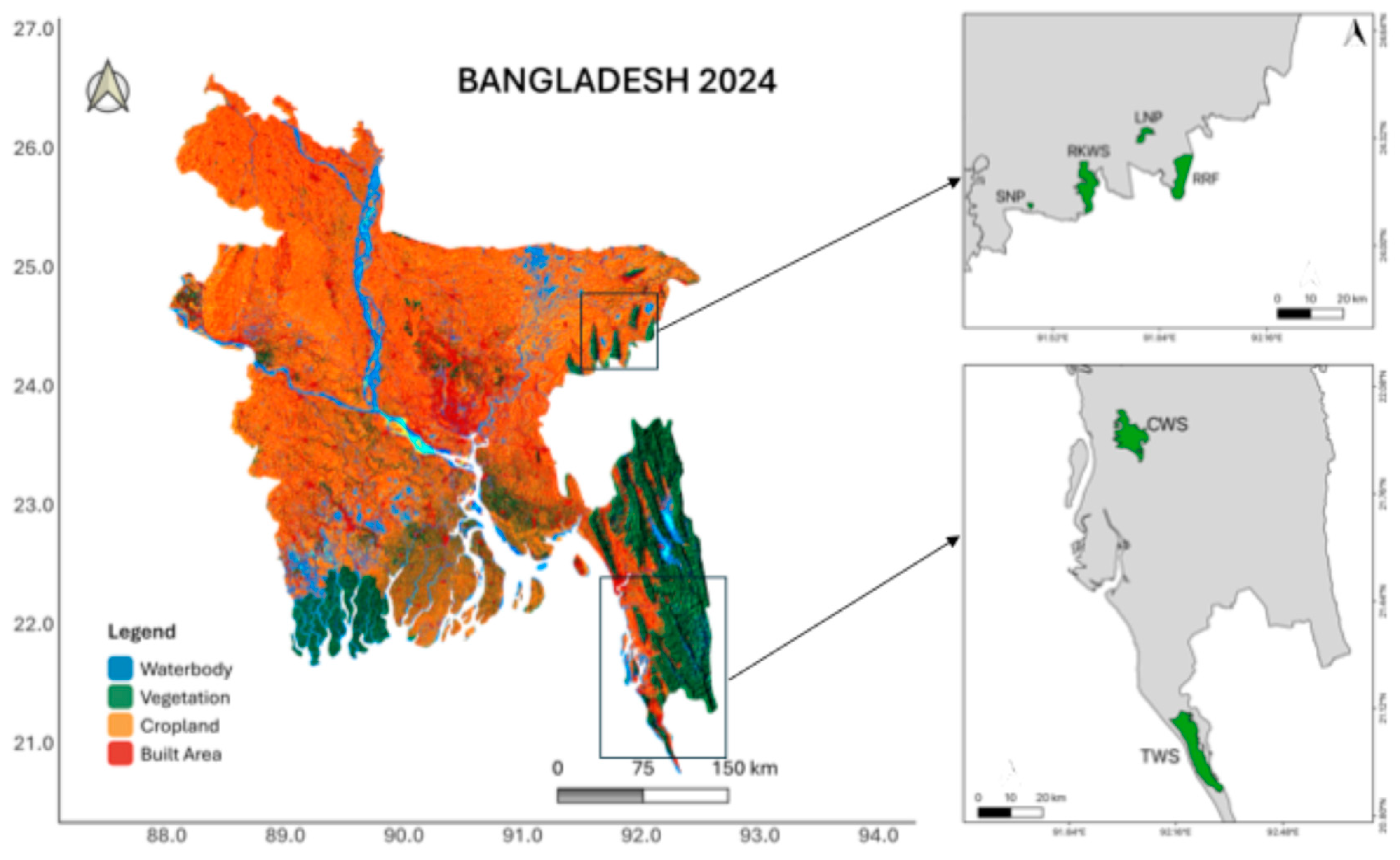
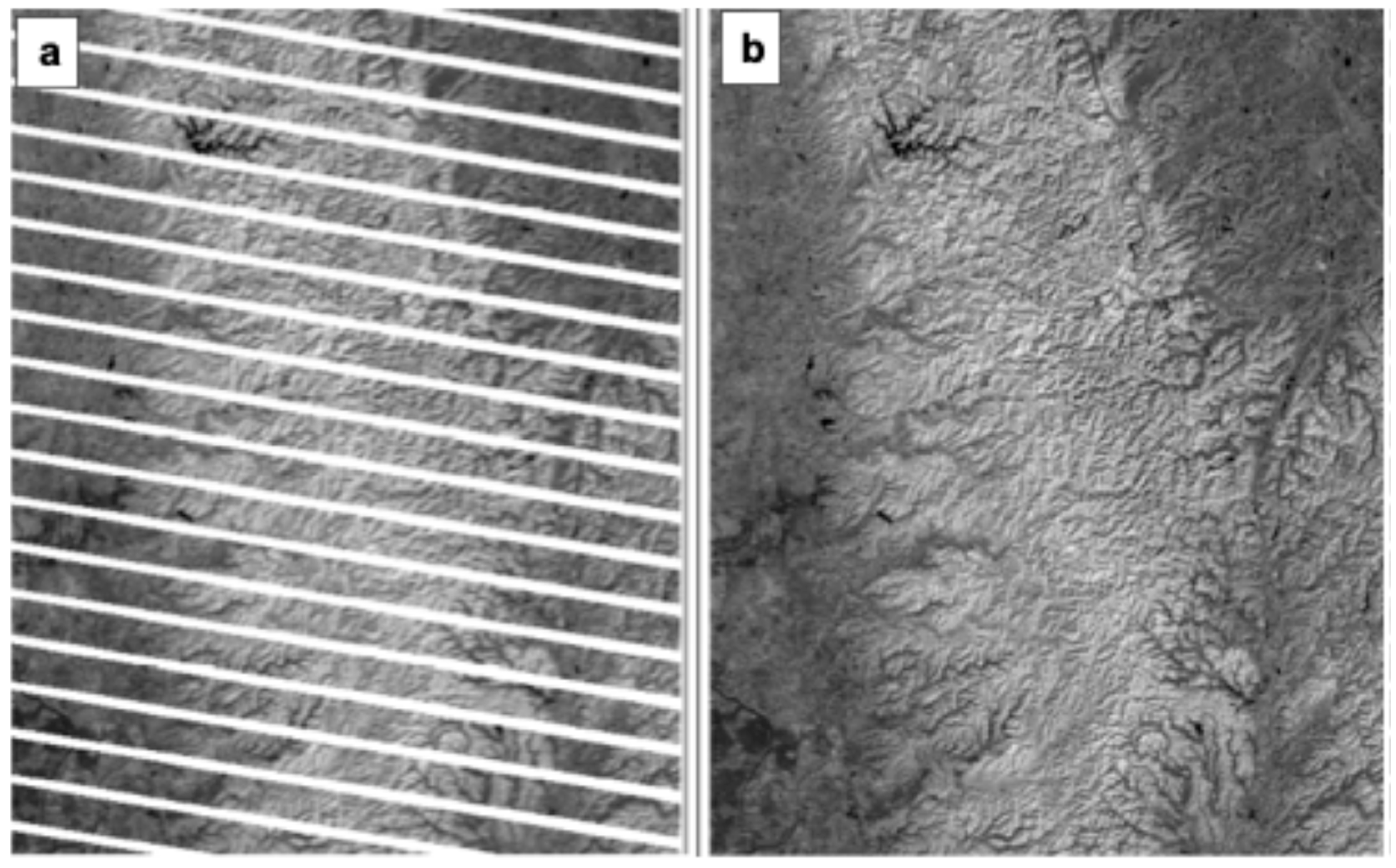
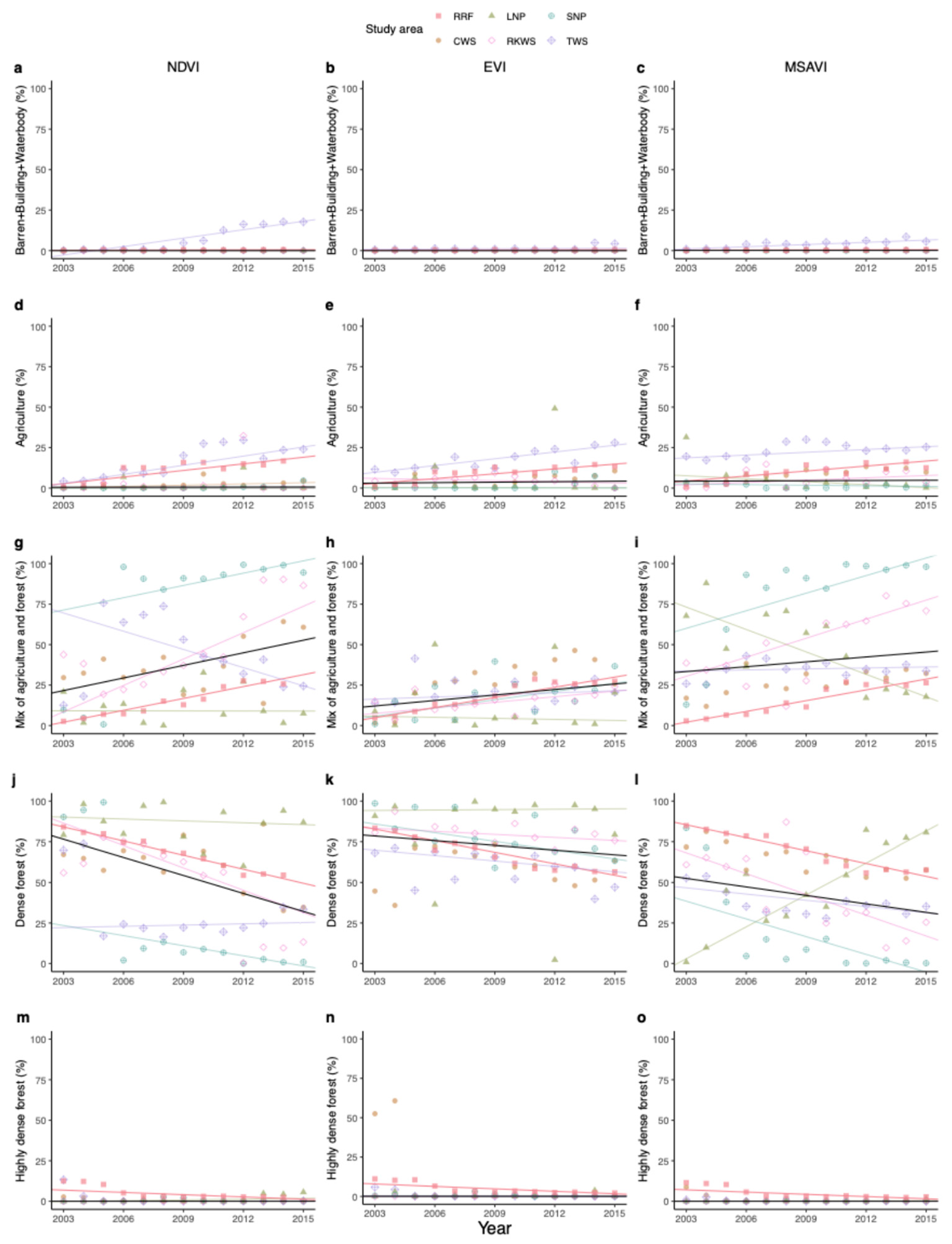
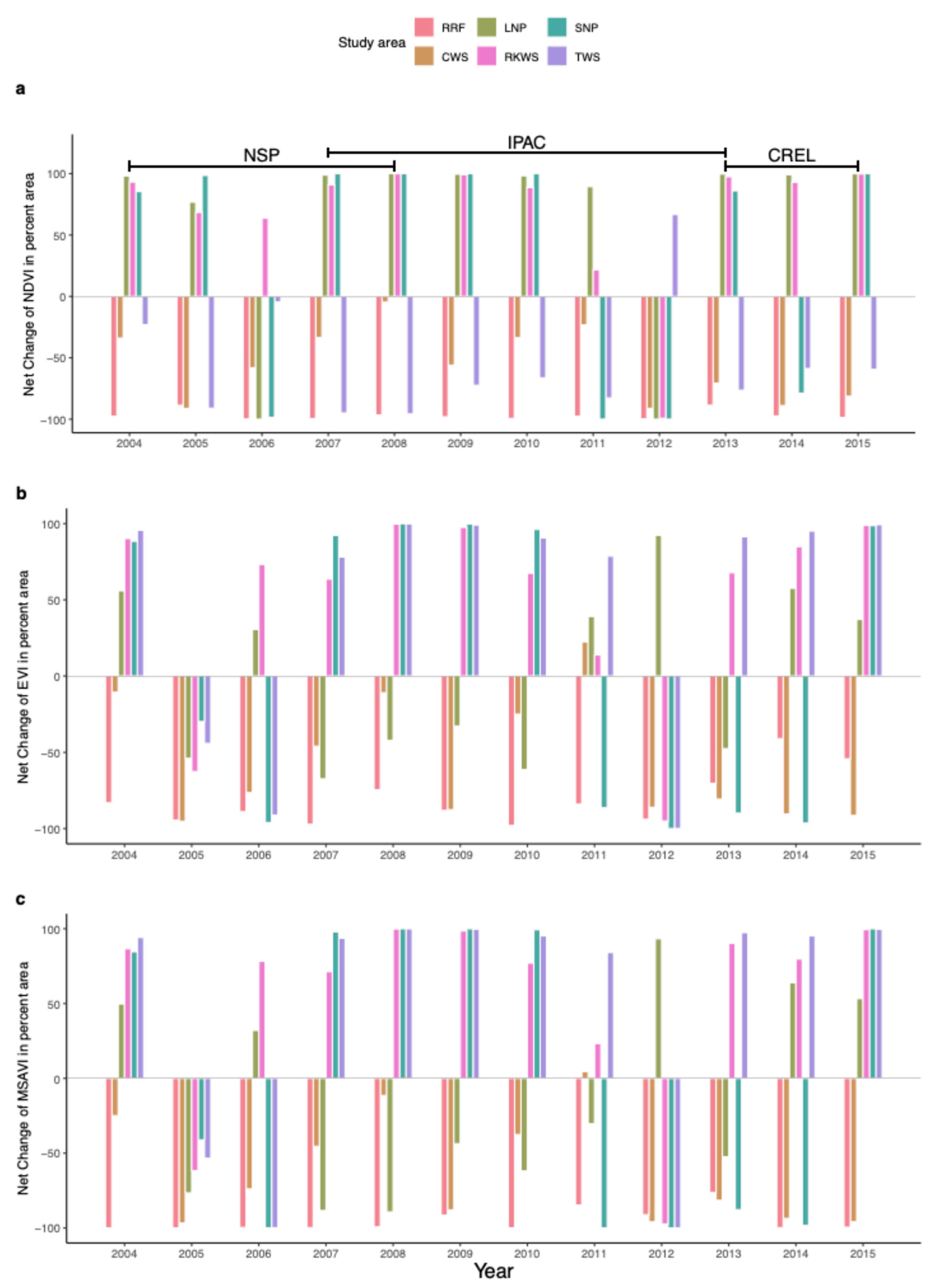
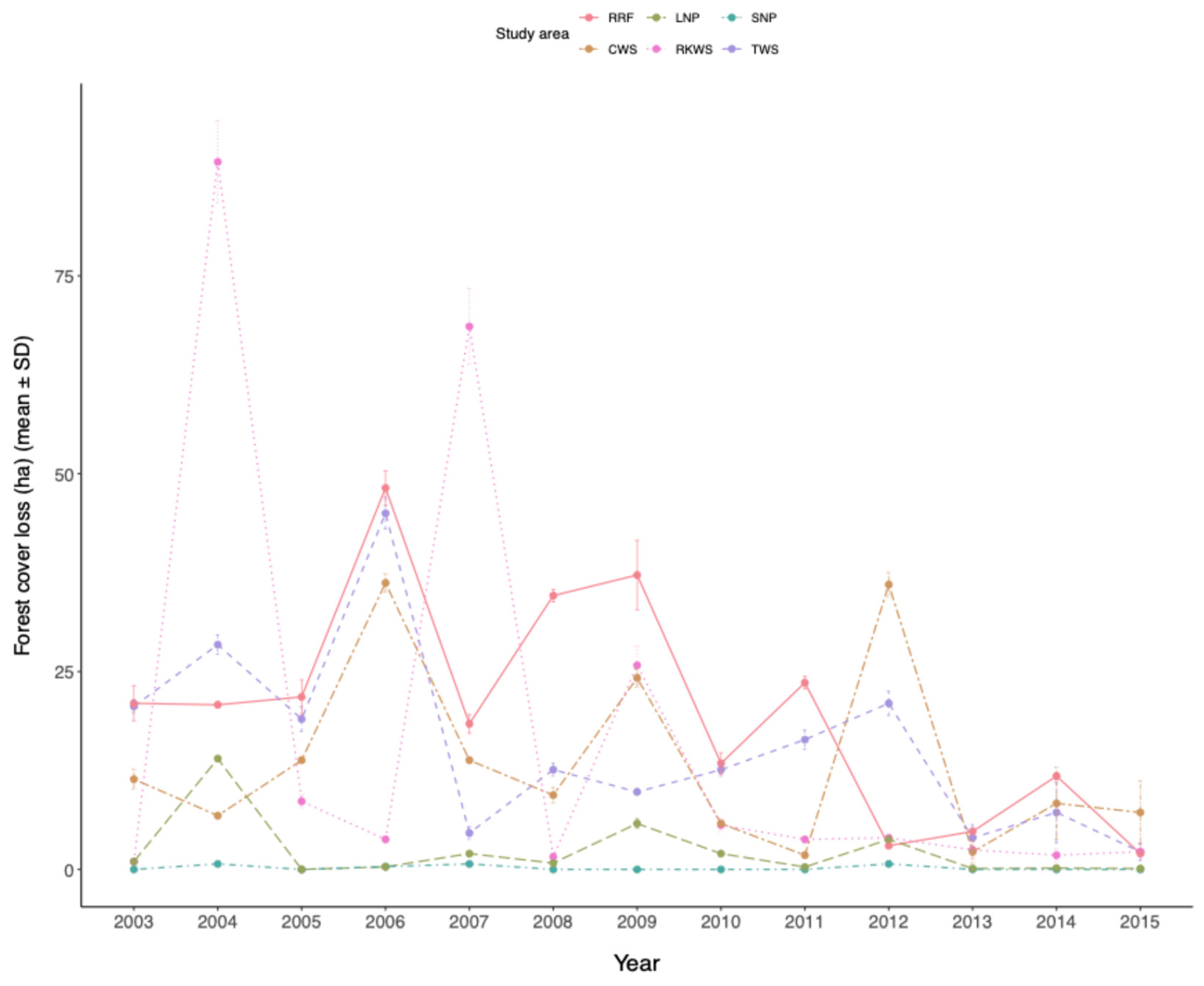
| Land Use Land Cover Classes | Threshold value | ||
|---|---|---|---|
| NDVI | EVI | MSAVI | |
| Barren, with waterbodies, and built-up | 0 – 0.19 | 0 – 0.14 | 0 – 0.19 |
| Agriculture | 0.2 – 0.4 | 0.15 – 0.29 | 0.2 – 0.3 |
| A mix of agriculture and forest | 0.41 – 0.6 | 0.3 – 0.34 | 0.31 – 0.41 |
| Dense forest | 0.61 – 0.8 | 0.35 – 0.54 | 0.42 – 0.65 |
| Highly dense forest | 0.8 < | 0.55 < | 0.65 < |
| PAs | LULC classes | NDVI | MSAVI | EVI | ||||||
|---|---|---|---|---|---|---|---|---|---|---|
| tau | p | slope | tau | p | slope | tau | p | slope | ||
| Overall | Barren-building-waterbody | -0.38 | < 0.01 | -2.1e-17 | -0.25 | <0.01 | 9.8e-16 | -0.29 | <0.01 | 1.05e-16 |
| Agriculture | -0.17 | 0.04 | 0.01 | -0.22 | <0.01 | 0.04 | -0.15 | 0.07 | 0.09 | |
| Forest-agriculture mosaic | 0.13 | 0.12 | 2.59 | 0.37 | <0.01 | 1.00 | -0.13 | 0.10 | 1.13 | |
| Dense forest | -0.15 | 0.07 | -3.7 | -0.28 | <0.01 | -1.74 | 0.29 | <0.01 | -0.96 | |
| Highly dense Forest | -0.15 | 0.08 | 1.3e-17 | -0.28 | <0.01 | -6.9e-2 | -0.12 | 0.16 | -0.003 | |
| CWS | Barren-building-waterbody | -0.02 | 0.95 | 0.00 | 0.38 | 0.07 | 0.01 | 0.05 | 0.85 | 0.0009 |
| Agriculture | 0.46 | 0.03 | 0.25 | 0.76 | <0.01 | 0.91 | 0.48 | 0.02 | 0.63 | |
| Forest-agriculture mosaic | 0.28 | 0.20 | 2.43 | 0.53 | 0.01 | 1.34 | 0.64 | <0.01 | 2.94 | |
| Dense forest | -0.25 | 0.24 | -2.15 | -0.59 | <0.01 | -1.74 | -0.12 | 0.58 | -0.96 | |
| Highly dense Forest | -0.66 | <0.01 | -0.04 | -0.82 | <0.01 | -0.023 | -0.28 | 0.20 | -0.009 | |
| TWS | Barren-building-waterbody | 0.87 | <0.01 | 1.73 | 0.77 | <0.01 | 0.455 | 0.30 | 0.16 | 0.05 |
| Agriculture | 0.69 | <0.01 | 1.87 | 0.35 | 0.09 | 0.57 | 0.74 | <0.01 | 1.39 | |
| Forest-agriculture mosaic | -0.25 | 0.24 | -3.75 | 0.05 | 0.85 | 0.202 | 0.17 | 0.42 | 0.43 | |
| Dense forest | 0.07 | 0.76 | 0.25 | -0.33 | 0.12 | -1.28 | -0.43 | 0.04 | -1.11 | |
| Highly dense Forest | 0.24 | 0.28 | 0.002 | -0.30 | 0.19 | -0.0007 | -0.35 | 0.09 | -0.016 | |
| LNP | Barren-building-waterbody | 1.0 | 1.0 | 0.00 | -0.14 | 0.56 | 0.00 | 0.19 | 0.50 | 0.00 |
| Agriculture | -0.23 | 0.31 | -0.0006 | -0.46 | 0.03 | -0.61 | -0.15 | 0.50 | -0.023 | |
| Forest-agriculture mosaic | -0.05 | 0.854 | -0.017 | -0.56 | <0.01 | -4.62 | -0.05 | 0.85 | -0.22 | |
| Dense forest | -0.10 | 0.669 | -0.387 | 0.667 | <0.01 | 6.55 | 0.05 | 0.85 | 0.08 | |
| Highly dense Forest | 0.38 | 0.09 | 0.158 | 0.49 | 0.03 | 0.03 | 0.20 | 0.38 | 0.02 | |
| SNP | Barren-building-waterbody | -0.32 | 0.22 | 0.00 | 0.09 | 0.738 | 0.00 | -0.07 | 0.84 | 0.00 |
| Agriculture | 0.55 | 0.01 | 0.021 | -0.19 | 0.389 | -0.12 | 0.185 | 0.43 | 0.00 | |
| Forest-agriculture mosaic | 0.53 | 0.01 | 2.53 | 0.64 | <0.01 | 3.62 | 0.41 | 0.05 | 1.70 | |
| Dense forest | -0.61 | <0.01 | -2.08 | -0.69 | <0.01 | -3.64 | -0.48 | 0.02 | -1.78 | |
| Highly dense Forest | -0.05 | 0.86 | 0.00 | -0.05 | 0.86 | 0.00 | -0.37 | 0.10 | -0.023 | |
| RKWS | Barren-building-waterbody | -0.02 | 1.0 | 0.00 | -0.14 | 0.54 | -0.003 | -0.25 | 0.27 | -0.0002 |
| Agriculture | -0.23 | 0.29 | -0.01 | 0.33 | 0.12 | 0.47 | -0.20 | 0.36 | -0.23 | |
| Forest-agriculture mosaic | 0.61 | <0.01 | 5.42 | 0.53 | 0.01 | 3.92 | 0.43 | 0.04 | 1.14 | |
| Dense forest | -0.53 | 0.01 | -4.58 | -0.48 | 0.02 | -4.27 | -0.33 | 0.12 | -0.62 | |
| Highly dense Forest | 0.07 | 0.79 | 0.00 | -0.13 | 0.61 | 0.00 | 0.20 | 0.38 | 0.006 | |
| RRF | Barren-building-waterbody | 0.008 | 0.92 | 0.024 | 0.05 | 0.51 | 0.02 | 0.01 | 0.87 | 0.02 |
| Agriculture | 0.14 | 0.08 | 1.35 | 0.11 | 0.16 | 1.02 | 0.15 | 0.05 | 0.99 | |
| Forest-agriculture mosaic | 0.23 | <0.01 | 2.44 | 0.14 | 0.07 | 2.22 | 0.29 | <0.001 | 2.09 | |
| Dense forest | -0.32 | <0.001 | -2.88 | -0.20 | 0.01 | -2.63 | -0.21 | <0.01 | -2.36 | |
| Highly dense Forest | -0.05 | 0.55 | -0.47 | -0.11 | 0.20 | -0.46 | -0.13 | 0.09 | -0.52 | |
Disclaimer/Publisher’s Note: The statements, opinions and data contained in all publications are solely those of the individual author(s) and contributor(s) and not of MDPI and/or the editor(s). MDPI and/or the editor(s) disclaim responsibility for any injury to people or property resulting from any ideas, methods, instructions or products referred to in the content. |
© 2024 by the authors. Licensee MDPI, Basel, Switzerland. This article is an open access article distributed under the terms and conditions of the Creative Commons Attribution (CC BY) license (http://creativecommons.org/licenses/by/4.0/).





